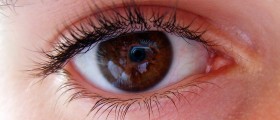
The condition usually does not occur alone and is most commonly associated with ocular myopathy and intranuclear ophthalmoplegia. Inadequate control over eye muscles does not allow them to move together and this is why patients may complain about double vision. There are also additional symptoms and signs which generally depend on the underlying condition.
What Causes Chronic Progressive External Ophthalmoplegia and Its Symptoms
This medical condition has one most prominent characteristic, progressive limitation of eye movements which is frequently accompanied by drooping eyelids. In people whose both eyes are affected and if the course of the disease is gradual double vision does not even have to occur. Chronic ocular external ophthalmoplegia starts during childhood and young adolescence and sometimes its symptoms first develop in adulthood.
Patients suffering from myopathic ophthalmoplegia may complain about weakness of the face or even muscles involved in swallowing. Weakness of the neck and the extremities occurs as well. Progression of the disorder is associated with specific neurological syndromes such as familiar form of spastic plegia, spinocerebellar disorder and sensorimotor peripheral neuropathy. One syndrome, called Kearns-Sayre syndrome also affects the retina, causing its depigmentation and is additionally capable of inducing heart block, increase in protein in the cerebrospinal fluid and progressive disabling lack of muscle control.
The disease can be inherited or acquired and in the last case it occurs sporadically and has no family history. The condition also accompanies other neurologic disorders such as multiple sclerosis, certain types of cancer and Chiari type II malformation. Furthermore, it can affect people suffering from progressive supranuclear palsy, diabetes mellitus, brainstem tumors, stroke migraine etc.
Diagnosis and Treatment for Chronic Progressive External Ophthalmoplegia
The diagnosis is set according to patient's medical history, physical and neurological as well as ophthalmologic examination. Muscle biopsy is also essential as well as additional test and exams including CT scan or MRI of the brain or spinal tap. If the doctor suspects on multiple sclerosis, additional tests regarding nerve response are performed.
Unfortunately, there is no treatment for the disease. Patients with Kearns-Sayre syndrome may benefit from vitamin E and generally require a pacemaker, while others are administered coenzyme Q. Diseases that induce chronic progressive external ophthalmoplegia require specific treatment. Mechanical treatments may correct drooping eyelids and if there is absence of blink response, patients are due to use artificial tears and wear an eye patch at night.
- medlineplus.gov/eyemovementdisorders.html
- medlineplus.gov/degenerativenervediseases.html
- Photo courtesy of Juan A Mendez, Cristhian R Arias, Diego Sanchez, Luis M Pesci, Brenda S Lopez, Ruben Lopez and Elvira Castro by Wikimedia Commons: commons.wikimedia.org/wiki/File:Tolosa-hunt_ophtalmoplegia.jpg

















Your thoughts on this
Loading...